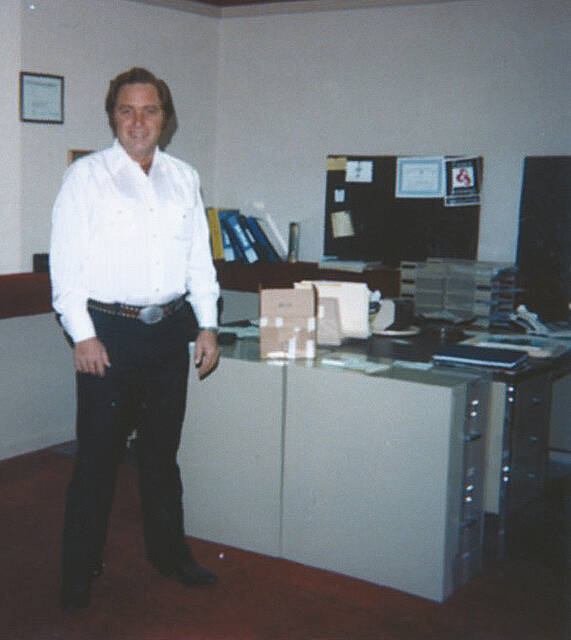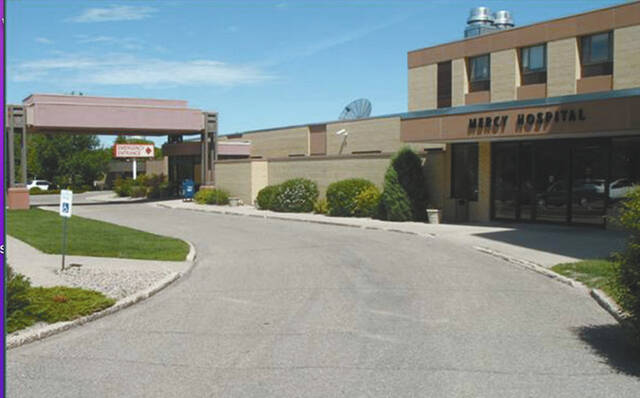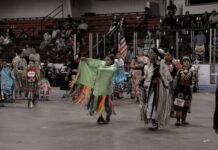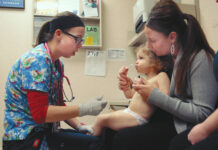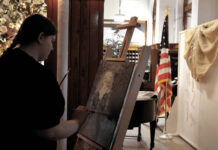National Hospital Week USA is May 11-17
National Hospital Week is May 11-17 and I would like to honor all our small local hospitals who are oftentimes the life blood of a community. This story is about those hospitals.
So what are the Glory Days of Healthcare? Well if you are working in the healthcare field right now, hopefully for you these are the Glory Days. For myself though the Glory Days were the 1970’s and 80’s.
I was a Respiratory Therapist for 47 years beginning in 1974 and I have had the privilege of working in hospitals, Home Care, sales, and Sleep Medicine. The old adage “ if you love what you’re doing you will never work a day in your life” applies to me. Everyday was a new adventure!
I would like to provide you with a little background for this story. In 1980 I started the first Home Medical Equipment and Respiratory Home Care business in the state of North Dakota. It was called Country Health. In 1986 I sold that business and started a similar one for Mercy Hospital in Devils Lake and that was called C.A.R.E. Medical and I managed that for 20 years. Our service area was about an 80 mile radius of Devils Lake and over the years I have had interactions with thousands of customers and have had the privilege of providing health care to people in their homes. I have been in hundreds of homes throughout this area.
Our business focus was to serve the rural areas and the small hospitals. I have had working relationships with the management of all these local hospitals and I have come to know many of the staff of them.
Throughout this story I am sure you will recognize your hospital especially if you were working in healthcare at the time. Although the central story is about Mercy Hospital in Devils Lake, it is also about every other hospital as even though they are all different, they are all similar, too.
1976 was a great year! My wife Linda and I were married in June of that year, we moved to Devils Lake and we both began employment at Mercy Hospital.
I was the Assistant Manager of the Respiratory Therapy (RT) department and Linda was a RN in Pediatrics. Our new life was very exciting. But then life threw us a little curveball. The RT department at Mercy was managed by a Contract Company, Respiratory Consultants, Inc. (RCI). They managed most of the RT departments in the smaller hospitals in North Dakota.
RCI decided I was Manager material so in the fall of 1976 they transferred me to the Langdon Hospital where I was the manager of one employee, myself. Linda got a job as a staff RN at the hospital and she also taught the Health Careers class at the Langdon high school.
The Langdon community and the hospital were wonderful places to live and work. Everyone there was so nice and we really enjoyed living there. Langdon was in a boom era as the Nekoma ABM Missile Site was being built and there was a huge influx of new people to the community. Businesses were doing very well, real estate was at a premium, and the hospital was very busy.
However, shortly after we moved to Langdon the ABM Site was shut down. Ironically the day after it officially opened! The boom in Langdon was over and all these people that had moved there were leaving. Almost overnite Langdon went from a boom town to just another pleasant little North Dakota town.
Without all these extra people the hospital was very slow and Linda and I were very concerned about our jobs. But once again our life was about to change! In late summer of 1977 I heard a rumor that Mercy Hospital in Devils Lake was not re-newing their RT contract with RCI and the hospital was planning on starting their own RT department.
I called my friend Cliff Larson, the Assistant Administrator at Mercy and asked him if that was true. He said it was and they needed a manager for the department. He asked if I wanted the job, I replied yes I did, he said great, stop by some day and we’ll talk about what we will pay you and probably sign some papers.
A few days later I met with Cliff, we agreed on a salary, he said welcome aboard, we shook hands and just like that I was a Mercy employee. That was it, I never even filled out a job application! But that’s the way things were done a lot of times back then, on a handshake.
I started work at Mercy again in the fall of 1977 as the Respiratory Therapy department Manager. My wife Linda began employment there a little later as a Labor and Delivery nurse and she worked at this position for 38 years. And then life got even better for us, we had our first child in December of that year!
Back then the economy was not very good and good paying jobs with benefits were hard to come by so if you were lucky enough to get one of these good jobs, you kept it. The local hospitals were usually the biggest employer in town and the pay and benefits were better than anywhere else. So when you got a job at a hospital, most often you kept it for your entire working career.
When Linda and I got hired at Mercy Hospital we felt like we were set for life. And we were! At that time there were many other younger people hired at the hospital in all the departments. There were even some younger Doctors that started their practices then. In retrospect it was like a “changing of the guard”.
We all started our careers together, bought our first homes, had our children and they grew up together, and then just like that 40 years later we all started retiring. The years went by so fast!
The provision of healthcare back in 1977 was much simpler than it is now. It was an exciting time as healthcare was rapidly evolving with new technology. This may seem a little controversial but the space program had a lot to do with this new technology.
A lot of diagnostic and treatment procedures in Cardiac and Respiratory can be attributed to the space program. One example is the invention of the oxygen concentrator, a device that literally makes it’s own oxygen. This was a huge advancement for respiratory and cardiac patients, hyperbaric, home care, and the list goes on and on.
There were many other factors that helped fuel this boom in the healthcare field and I will touch on many of them throughout this story.
Mercy Hospital was licensed for 110 beds in 1977 but in the winter months it would swell to as high as 115 during the flu and pneumonia season. We would put beds in the hallways with privacy curtains around them.
Patients were kept in the hospitals longer back then as there was no home care. Medicine was also more reactive than proactive. You went to the Doctor if you had a medical problem, routine check-ups were rarely done.
Mercy Hospital in Devils lake was one of the more advanced hospitals within the state and was very well respected. It had several ancillary departments such as Respiratory and Physical Therapy, very modern and up to date Laboratory and Radiology departments and it had a 6 bed ICU/CCU with cardiac care nurses to staff it. Several of the Doctors performed or assisted with surgeries so there were many surgeries done each day. There were 2 full time nurse anesthetists.
Patients were rarely transferred to bigger hospitals as they are now. Mercy had the facilities, equipment, and skilled staff to handle most medical challenges. Some of the reasons then for transferring a patient were severe head and/or spinal injuries, severe burns, severe cardiac issues, advanced orthopedics procedures, and babies requiring NICU.
I remember one transfer we did to St. Luke’s in Fargo. I don’t recall the exact medical problem of the patient but he was on a ventilator. He was so critical it was decided to transfer him by air. Back then there were no air ambulances around or Medivac helicopters but there was Bob Meiers and his fixed wing airplane. Bob was very good at air transfers even though his plane wasn’t exactly setup for patient care.
The challenge was how to transfer the patient on a ventilator as there were no small compact portable ventilators back then. So I modified an IPPB machine into a pressure ventilator. It was called a TV2P. It was small enough to be used as a portable ventilator but it required a 50 psi power source. And for this I used an H size oxygen tank. The big one.
The Devils Lake ambulance transported the patient, a nurse and myself to the Devils Lake airport where we boarded Bob’s airplane. The back of the airplane was empty but the space was kind of small. The nurse (I don’t remember her name) boarded first, the patient was on a litter so he was boarded next, then the big oxygen tank and myself got aboard.
We layed the oxygen tank on the floor and I sat on it with my back against the side compartment door. It was pretty cramped but it worked. Once we were up in the air though, Bob leaned back and said to me “I wouldn’t lean against that door if I were you, they do have a tendency to open up.” I said WHAAAT!
So the rest of the trip to Fargo I sat on the oxygen tank leaning forward with one eye on the door and one eye on the patient! But we had a nice uneventful flight and when we landed at the Fargo airport we transferred the patient into the Fargo Ambulance Service and they took him to St. Luke’s hospital.
The flight back to Devils Lake was very pleasant and as a bonus we got to listen to Bob entertain us with his aviator adventure stories. Bob was a good story teller!
Devils Lake had many good Doctors and most of them were associated with the Devils Lake Clinic. In fact, it was owned by them. It was located just a few yards west of the hospital. There were 2 Doctors who had their own clinic downtown, Dr’s Mahoney and Lazarek.
The doctors and the hospital all worked well together to give the patient optimum care. Back then when you first went to a doctor., they then became your doctor all the time. The doctor knew you.
The doctors took turns being on call for the Emergency Room at the hospital. But if you should end up in the ER, once the doctor on call saw you, then your doctor would be notified and if they felt it was necessary they would come to the ER and see you. So basically doctors were unofficially on call all the time.
Dr. Gilbertson told me once he thought the reason he had a heart attack in his early 60’s was because of all the sleep he lost because of getting called in to the ER all the time. I know Dr. McBane felt the same way. Scientific evidence now proves that the lack of sleep can cause cardiac problems.
Being a doctor back then was a 24 hour a day job and the only way to avoid it was to take a vacation out of town.
In the late 1970’s not only was there a “changing of the guard” at the hospital, the doctors were also changing some. Long time doctors such as Dr. John Fawcett, Dr. Connor Corbett, and Dr. Glenn Toomey were preparing for a well deserved retirement as they started their careers as country doctors and in the early years they did a lot of house calls in all sorts of weather, a lot of times for very little pay.
A good country doctor story concerns Dr. Jim Mahoney (who later in life became the Devils Lake Mayor). In the winter of 1949 there was a good old fashioned snow storm. Lots of snow and a north wind that kept whipping snow drifts higher and higher. There was no traffic moving on the roads.
There was a very pregnant lady on a farm by Lakota who was starting to experience labor pains even though the baby wasn’t due for another five or six weeks. She was becoming very concerned. Her neighbors hitched a team to a sleigh to try to get her to town but the snow was so deep they had to give up.
The next morning things were becoming critical so the family called Lakota’s only airplane pilot to see if he would fly out and rescue her. No way would he attempt it. Then they called Dr. Jim Mahoney in Devils Lake. He contacted a Devils Lake pilot, Dan Wakefield, and together they flew to the ladies farm and landed the plane on skis.
Dr. Mahoney bundled the lady into the plane and they flew to Devils Lake. When they landed at the Devils Lake airport, Dr. Mahoney put her in his car and drove as fast as possible to Mercy Hospital. The new soon to be mother was so relieved that once she was in the arms of caring nurses, she passed out. When she woke up they brought her the little snow baby who was doing well with the special care of the nurses.
I’m sure there are many wonderful stories of these heroic country doctors who would risk life and limb to help a patient.
Devils Lake had several middle-aged doctors at that time and several new doctors joined the clinic in the late 1970’s. All these doctors had their own areas of expertise such as OB, Pediatrics, Internal Medicine, Orthopedics, and Surgery. For example Dr. Pine’s was Urology, so he became the “old man’s” Dr. as he did a lot of TUR procedures. If you don’t know what a TUR is, look it up. It’s usually considered an old guys problem.
Dr. Panuwat was a well respected Surgeon and was qualified to do a wide range of surgeries. Between all of the doctors there were several surgeries each day. Most of the doctors practices back then weren’t just limited to one area, though, most doctors saw a wide range of patients during the day. Sending a patient to a Specialist was pretty rare, not like it is today.
If you work in healthcare and you want to be really great at your job there are several skills and traits you need. First you need to comprehend and remember tons of medical information. You need to be a good critical thinker and you need compassion and empathy.
Why “The GloryYears” of Healthcare?
I consider the 1970’s and 80’s (the olden days) the Glory Years of Healthcare for many reasons. First of all there were no computers. The doctor was in charge of your healthcare, not the insurance company. When the doctor ordered a test or procedure the insurance company complied with it. Not like today where the doctor has to check and see if your insurance will pay for it before they order it.
Medicare and Medicaid were new yet and so they hadn’t had the time to start a whole bunch of rules and regulations. They pretty much went along with what the doctor ordered. Blue Cross was the carrier for Medicare in North Dakota and they were easy to deal with. If you called Blue Cross the phone was answered by a person and the person you talked to was usually the same person you had talked to the other times you had called them. Sometimes they would even call you with a question!
In the early 1980’s Home Care was just beginning and people were getting sent home with oxygen and nebulizers. But Medicare and Blue Cross were not sure what all the equipment was or what it did so they were not sure how to pay for it.
So one day I scheduled an inservice with the Blue Cross staff in Fargo to show and explain this equipment to them. This was when their office was located in a field in West Fargo. I brought all the equipment with me, demonstrated it to them and explained the medical and cost saving advantages of each piece of equipment. And from then on they had set payment amounts for each item. Try doing that today and see if you could even get in the building!
The billing for medical care was much simpler. You provided the medical care that the doctor ordered and then you sent the bill to the insurance company for this care and they sent you a check back. How simple was that! Sure it probably took 30-60 days to get paid but at least you got paid a close amount to what you charged.
I believe it was much easier for the hospital or clinic to stay solvent back then than it is now. Cliff Larson from Mercy Hospital explained to me once about how hospitals and nursing homes were pretty much guaranteed to make a profit of 12%. I don’t remember exactly how it all went, as it was a complicated formula, but each insurance company was evaluated at the end of the year and if on their payments the facility made more or less than 12% the insurance company either reimbursed the facility for the difference or the facility reimbursed the insurance company.
I think this so called “assured profit” is what kept most small hospitals solvent. Once it was taken away is when you saw those hospitals struggle to stay open and sometimes close.
The local hospital was the economic driver in a community. They were the largest employer and had the best pay structure. As they were either religious or community hospitals all the money stayed within that community. They utilized local banks and donated heavily to the community. They did not have to send fees to corporate offices in other states so the money stayed local.
The approach to money matters was much different than it is now. There was a philosophy that if you took care of the patient, the money will take care of itself. A very simplistic view but it was there.
If a community had a hospital they usually had at least 3 doctors and often times these doctors were related. I think the reason for 3 doctors was to provide the 24 hour 7 day a week service. Towns like Rolla, Langdon, and I think Cando and Rolette all had 3 doctors. Usually towns without a hospital only had 1 or 2 doctors. Once these doctors started retiring is when problems developed and hospitals had a whole new struggle to contend with.
In the mid 1970’s there was a sort of grass roots movement sweeping the country that for the most part was not even noticed by anyone except those who were involved in it. It was called CPR. That’s right, that CPR, Cardio Pulmonary Resuscitation.
In the early 1970’s the American Heart Association (AHA) made the bold goal to have every adult in America learn CPR. Before this the only people who knew CPR were those who needed to know it such as ER, ICU nurses, doctors, and ambulance personnel. Very few people of the general public knew how to do CPR or even what it was. The AHA did research for many years establishing parameters on how to effectively do CPR and these parameters were adopted by all healthcare organizations so everyone did it the same way.
The parameters included how to do chest compressions, how many to do, how deep to do them and to do them in conjunction with respirations either by bag mask or mouth to mouth. And these parameters were included for adults, children, and infants.
The AHA realized that to teach people how to do CPR, practice mannequins would be needed and it would require thousands of them. These mannequins were called Resusci-Annes and were manufactured by a company called Laerdahl. (A Norwegian company by the way.) So the AHA convinced Congress to provide money for local hospitals to purchase these mannequins provided they also provide CPR instructions to the community.
And then AHA realized they needed CPR Instructors to teach people. But these Instructors also needed to be trained and so they needed Instructor Trainers. These Instructor Trainers were expected to be the top level of CPR Instructors so the AHA asked healthcare facilities to provide them with candidates to be trainers.
And for some reason unknown to me, my boss, a fellow named C. Keith Smith, submitted my name and I was chosen as part of the first 12 people to be Instructor Trainers in North Dakota. Why he thought I would be good at that is beyond me as I had never taught a class of anything in my life. I was just a shy farm boy! But I did grow up in a Norwegian community so I was very good at drinking coffee and visiting. I guess that worked.
So one Saturday a group of 12 of us got together to learn to be CPR Instructor Trainers. In order to become a Trainer you needed to do a written test and score 100% on it. You also needed to perform CPR on a Resusci-Anne mannequin which had a recorder on it and produced a strip of what you were actually doing. You had to produce a 2 minute strip of perfect compressions and respirations. This was much harder to accomplish than it sounds and was very tiring. The caveat to this was you could re-do everything over and over until you got it right. It took many attempts to get a perfect strip and I had to take the written test twice. But we all got it done.
So the next weekend I taught my first CPR Instructor classes and I was very nervous. I think there was 10 in the class and I did have the help of another Trainer. The AHA required that all CPR Instructors also do near perfect strips and it was a lot of work for a person to do. But everyone eventually got through it.
After this these new Instructors started giving CPR classes and certifications to the general public. The response from the public to learning CPR was over whelming. Everyone wanted to learn it. Pre-registration for classes was required otherwise class sizes would be too large.
All communities started what was called CPR Committees and these committees organized CPR classes for anyone who wanted it. And the greatest thing about this CPR movement was it was all volunteer. To my knowledge no one got paid for it. It is just astounding on how it all worked out.
In the beginning the AHA was very paper oriented and we had to send in reams of paperwork for each person taking a class. They quickly discovered all this paper wasn’t really needed and so most of it was discontinued. The AHA over time also realized the goal of everyone doing perfect CPR was simply unattainable for most people and they decided that even bad CPR is better than no CPR.
CPR classes were fun but with the huge public demand for them, it quickly burned out the first group in Instructors. Eventually though we all learned to slow down and relax a little. CPR has changed quite a bit compared to what it is now. The focus now is more on compressions than respirations and children are now being taught to give CPR. And the advent of AED’s has been a real game changer.
In the late 1970’s and early 1980’s the Health Care Financing Administration (HCFA) which oversees Medicare and Medicaid finally realized that Home Care Nursing is less expensive and better for the patient than long term hospital stays. The rest of us already knew that as home care has been done since time began. It’s how people were taken care of before there were hospitals. In fact the Indian reservations were already using home care, they called it Field Health. These Field Health nurses were phenomenal ladies and often times provided the only health care to the residents of the reservation. In the early 1980’s the reservations in North Dakota were very, very poor, the housing was often times sub standard, and houses had multiple generations living in them, and the roads were bad. These Field Health nurses went to the houses and took care of their patients and did an excellent job of it.
In the early 1980’s HCFA approved Home Care Nursing which meant Medicare, Medicaid, and other insurances would now reimburse for it. So every hospital started a Home Health Agency. Most were owned and operated by the hospital although several hospitals contracted with a Contract Agency called Prairieland Home health. Prairieland was an excellent company, they provided the management of a Home Health Agency and they utilized local nurses to provide the Home Care. To my knowledge there was only one private Home Health Agency in the area not connected to a specific hospital and that is Tri-Care Home Health of Rolla. Another great Agency and they are still in operation today.
The goal of Home Care was to decrease the length of a hospital stay by having nurses oversee that care in the patient’s home. When a patient was discharged from the hospital the Home Care nurse would train and guide the patient’s family in the provision of care. The nurse would make routine home visits to help and monitor the patient’s treatment. It’s a proven fact that often times patients recover better and faster with the help from family members in their own homes.
This saved Medicare and insurances lots of money. But it also put some financial squeeze on hospitals as they had less hospital stays. Over time Medicare pushed for more Home Care by limiting hospitals on how long a patient can stay there. The new thinking was when a patient was admitted to the hospital you should start planning the discharge on the day of admission.
Home Care kept increasing for about 20 years and then HCFA got the idea that there was too much Home Care and started setting more regulations to make Home Care less affordable. Eventually it forced many Home Health Agencies to close so today there are very few of them. This was the beginning of the insurances dictating patient care instead of the doctors or the hospital. This was also the end of the Glory Years. There is an old saying, if you wait long enough the government will find a way to screw things up. And they did.
A home health nurse is a special kind of person as they perform care within a patient’s home. It is not always easy. When a patient is in a hospital it is easier to regulate their treatment because they are in a controlled environment. When a patient is in their own home the nurse is in their environment.
Hospices became another way of providing patient care. And Hospice nurses also have their special way of providing care. A nurse is trained that the goal is to improve the patient’s health. But in Hospice the goal is not as much to improve their health but to make them comfortable and prepare them and their family for the end result. I have found that Hospice nurses have a deep religious belief.
One of the best things about the Glory Years was the hospital Christmas party. As small hospitals considered their employees family, the Christmas party was a big family affair. At Mercy Hospital they would rent the Elks Club, hire someone to cook and serve a big meal, and hire a band for a fun night of entertainment and dancing.
Employees and their spouses, doctors and board members, and Administration personnel would all come, everyone would dress up, and everyone was equal. No bosses, no staff, just friends. It was such a fun night. And I know all local hospitals celebrate the same way.
Like all things in life though things changed, the big gala event was later changed to a meal for employees and spouses cooked and served at the hospital. And eventually there was no meal at all. We would get a frozen ham or turkey. Now from what I hear now you’re lucky to get a canned ham at Christmas!
When Marlene Krein was CEO of Mercy hospital she insisted that excess profits be shared with the employees in the form of a Christmas bonus. This would usually amount to an extra paycheck for everyone right before Christmas. What a gift! We got a Christmas bonus for several years and the last one was in 1996 when Catholic health Initiatives acquired the hospital. I know Marlene took a lot of heat from the larger hospitals for giving Christmas bonuses as they were afraid the idea might spread to them. But she persisted. No way would any hospital do that now!
So these are my Glory Years, hope you’re still living yours! Thank you for letting me share my story with you.


